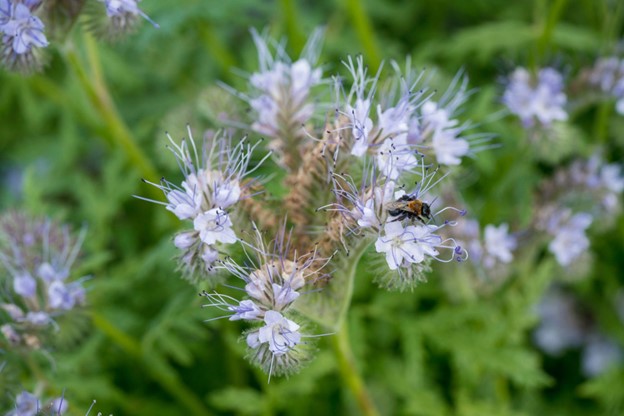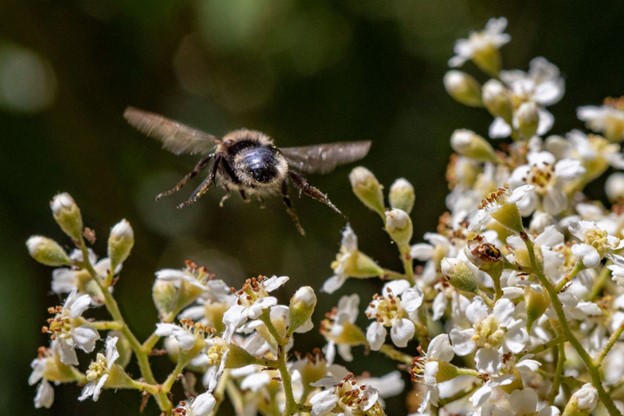By Sharon Beals and Lori Eanes – www.bernalwild.org
It’s pollinator week, and we were asked to discuss it. You’d think that people like us, who have taken up the crusade of planting native plants for the insects that depend on them, would be able to start writing.
But it’s a big subject, and before we attempt to talk about pollination, we might need to say a little more about what we are trying to do on a vacant lot on the shoulder of Bernal Hill. In the last three years, we’ve removed half a block of broom and planted a hillside of what might have grown here a hundred years ago—or at least some of their cousins. We’re trying our best to offset the 75% (or more) decline of insects by offering them the plants that they evolved with, plants that they and their larval offspring can eat.
The yarrow, buckwheats, sages, clarkias, monkeyflowers, needlegrass, blue-eyed grass, lupine, buckwheat, elderberry, and more are thriving, especially now as they are doing their blooming best to bring in the pollinators. Pollinators come in many forms: not only are there many species of bees, but also butterflies, moths, beetles, flies, and others spreading pollen from blossom to blossom.
Native plants not only host native pollinators but also many insects, including butterfly and moth larvae. Coast buckwheat hosts up to 31 butterflies and moths, and several lupine varieties are the only host plants to the locally endangered Mission Blue Butterfly and up to 25 other butterflies and moths.
We love pollinators and other bugs all over our plants, and they let us know that our habitat is working. A couple of weeks ago, we were excited to find a sphynx moth caterpillar in some Clarkia we planted. It’s fun to create a backyard habitat full of local plants. Sit back and watch the action; you will be surprised by the pollinators who show up.

The Soap plant (Chlorogalum pomeridianum)
The Soap plant (Chlorogalum pomeridianum) above opens in the late afternoon to attract bees and stays up late for night-flying moths.

Coast Buckwheat (Eriogonum latifolium) with a Checkerspot Skipper (top) and an Acmon Blue butterfly.
Coast Buckwheat (Eriogonum latifolium) with a Checkerspot Skipper (top) and an Acmon Blue butterfly. Coast Buckwheat hosts up to 31 butterflies and moth larvae.

Phacelia with a native bee.

Bumble bee flies into Toyon flowers.
About Bernal Wild
At the top of Bernal Hill lies a remarkable urban ecosystem, 20 acres of open space that is home to many native plants and animals that are still surviving in the heart of San Francisco.
The hill starts to bloom in early spring: clumps of hummingbird sage and checkerbloom on the far west corner and goldfields near the peak. Lomatium, buttercups, violets, and lupines emerge along the trails. Soap plants open late afternoons for night-flying insects. In summer, a large patch of clarkia thrives along Bernal Boulevard; tarweed survives in rocky gravel along the road, as do the yarrow and the buckwheat on the bare rock faces. Ceanothus, willows, and coyote bush neighbor the toyon that offers flowers for bees and winter berries for birds. Needle grass survives on the paths we tread. These local native plants are the foundation for the insects, birds, reptiles, and mammals that have evolved together over thousands of years. Historically, before cattle grazing was introduced, these native plants and others would have been much more abundant. In July, the hill that turns brown would be green with native grasses into the fall and covered with wildflowers and many more.

About us
We are a group of friends who share a passion for this fragment of wild and are working to recreate some of this habitat on neglected land surrounding Bernal Hill. We began in the spring of 2021 after one of us noticed a coast live oak surrounded by scotch broom. What began with freeing this oak and a neighboring toyon has become an ever-growing habitat restoration project. In just two years, the newly planted natives and the butterflies, moths, bugs, and birds that depend on them are thriving.
